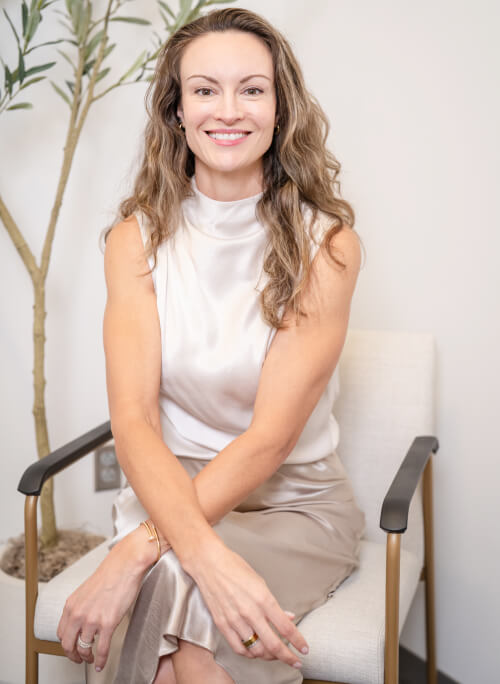Eyelid Skin Cancer Reconstruction
Learning that you have a skin cancer on your eyelid or near your eye can be a distressing thought. Unfortunately, since this area of the body receives significant sun exposure over the course of our lives, skin cancer of the eyelid is rather common. Removing the skin cancer is the first step. Dr. Langelier partners with talented local Mohs surgeons who are able to remove the skin cancer. The next step is to reconstruct the area to preserve your overall eye health and appearance. During skin cancer reconstruction, Dr. Langelier takes every step possible to help protect your overall eye health with just as much effort to restoring a natural and pleasing look to the eyelids after reconstruction.
Table of Contents
Toggle

Understanding How Skin Cancer Can Occur on the Eyelids
While the eyelid skin only makes up 1% of your body’s surface area, 10% of all skin cancers are located on the eyelids. Skin cancer is common in this area because it is so frequently exposed to the sun.
Basal cell is the most common type of skin cancer, followed by squamous cell carcinoma. Sun exposure is the number one risk factor for these skin cancers. While they can occur in younger patients, they are typically diagnosed in middle age or later. Melanoma and sebaceous carcinoma are less common but potentially deadly skin cancers that can spread to distant sites in the body, a process called metastasis.
Skin Cancer Reconstruction Before & After



Signs of Eyelid Skin Cancer
Signs of skin cancer include:
- Pearly-looking bumps
- Areas of ulceration/scabbing/bleeding that won’t heal
- Bumps with pronounced blood vessels
- New pigmented lesions (particularly those that are asymmetric, have irregular borders, or have irregular color)
While most bumps on the eyelids are not cancerous, it is vital to have a new eyelid bump examined and biopsied if necessary to evaluate them for skin cancer.
How Is Eyelid Skin Cancer Diagnosed?
Skin cancer is diagnosed by taking a biopsy. Dr. Langelier specializes in eyelid surgery and performs eyelid biopsies in her office multiple times a day. During the biopsy procedure, local anesthetic is carefully injected into the area to numb the region. The area is gently cleaned, and small tools are used to take a piece of the suspicious area. After the biopsy, the area often has a small scab, and it is normal to have a small amount of bloody oozing after the procedure. Antibiotic ointment will be prescribed to prevent infection. A patch is typically not needed, and you can use your eye to see right away, although your vision may be blurry due to the greasy ointment. For that reason, it is recommended that you bring a driver with you to your eyelid biopsy procedure.
What is the Process Like for a Skin Cancer Reconstruction?
Treatment of eyelid skin cancer has two steps:
- Skin cancer removal with clear margins
- Skin cancer reconstruction to repair the defect created by skin cancer removal
Step 1: Skin Cancer Removal
The most effective treatment for periocular skin cancers is surgical excision with Mohs micrographic surgery. This skin cancer removal is performed by a specialized dermatologist, called a Mohs surgeon, who is able to remove the skin cancer layer by layer. The goal is to remove all of the skin cancer while leaving behind as much healthy eyelid skin as possible. Dr. Langelier does not perform this procedure. If Dr. Langelier diagnoses you with an eyelid skin cancer, her team will help coordinate skin cancer removal by a Mohs surgeon and reconstruction with Dr. Langelier typically occurs the day after the Mohs excision.
Step 2: Skin Cancer Defect Reconstruction
After all of the skin cancer is removed, there will be a defect (area of missing skin or eyelid) that needs to be repaired. Reconstruction of skin cancer defects around the eyes is an area of expertise for the oculofacial surgeon. Eyelid reconstruction is usually an outpatient procedure performed at an outpatient surgery center or in the office. Local anesthesia and sedation are used for your comfort. The goal of eyelid reconstruction is to restore eyelid function, help you maintain your vision, and keep your eyes healthy. Dr. Langelier also strives to help you maintain a natural appearance after eyelid reconstruction.
Are There Alternatives to Skin Cancer Reconstruction?
Your dermatologist or Mohs surgeon can discuss alternatives to surgical excision of your skin cancer. In very large and involved skin cancers, additional treatment such as radiation or chemotherapy may be recommended.
Early treatment of skin cancer is crucial for good outcomes. Schedule an appointment if you notice:
- Skin concerns around the eyes, including new lumps or bumps
- Areas of ulceration that will not heal
- New pigmented spots
- An area of missing eyelashes
- A change in the appearance of an existing mole
The content on this page is generalized information and is not medical advice. You will receive your own customized instructions from our providers.

